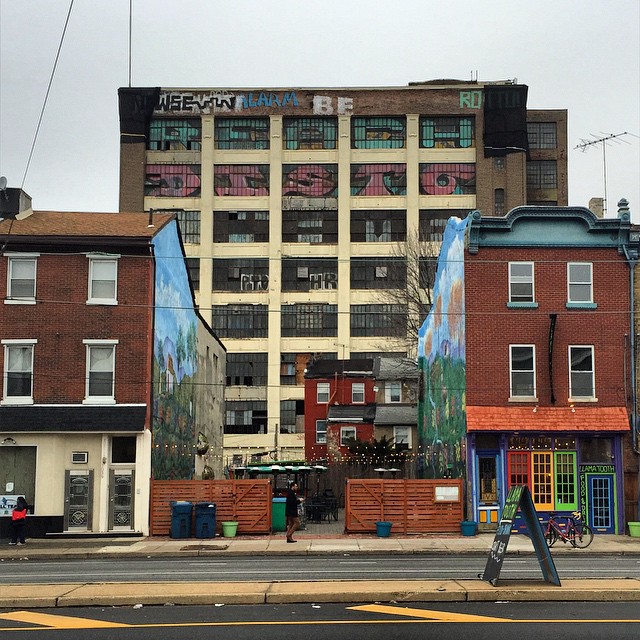
Apologies that this particular link-o-rama is full of self-promotion and conflicts of interesting, but I do think these are all interesting projects and I hope you do too:
- It takes a lot to get my excited about a mural festival, but this year’s Wall\Therapy in Rochester, NY looks great. It’s difficult to put on a mural festival. One short cut is to work with obvious artists. Your festival will look like 50 other festivals, but the walls will probably seem impressive. Wall\Therapy has not gone that route. This year in particular, they put together a surprising and diverse line up to create an arguably cohesive body of new work, and the quality of the murals is still strong pretty much across the board. Check out Brooklyn Street Art’s photos and review for the full story.
- From the selections I’ve read, I’m still not sure how I feel about the book What Do One Million Ja Tags Signify? by Dumar Novy, but a philosophy book centered on the work of a prolific graffiti writer seems like something that should at least catch the interest of Vandalog readers.
- Phlegm is in the middle of his latest art-making experiment, spending a month making art in the woods of rural England. I’m loving the results so far, and of course the concept of challenging himself in this way.
- Shepard Fairey’s latest print about corporate greed and campaign finance reform is about to drop. It’s a nice print, and I’m always glad to see Shepard tackling this important but not particularly sexy topic. Plus, the profits from this print go to two great organizations fighting for campaign finance reform. I’ll just note that Shepard is working on a couple of projects right now for my employer, but campaign finance reform and political corruption really are topics that I care a lot about.
- Speaking of my employer, I recently got to work on a really fun project with the City of Philadelphia Mural Arts Program and Ben Eine. Back in June, Eine came to Philly for a few days and painted almost 40 of his classic shutter letters. Philly now has a complete Eine alphabet, and then some. Eine’s work can be found throughout the city, but the shutters are definitely clustered in South Philly around Southeast by Southeast, a community center and art space for the neighborhood’s large Southeast Asian refugee community. Brooklyn Street Art has more on this project.
- And one more Mural Arts project to mention: JR recently installed a huge mural right in the heart of Philadelphia as part of Open Source, our public art exhibition curated by Pedro Alonzo. The mural is a portrait of Ibrahim Shah, a local food truck chef who came to Philadelphia from Pakistan about a year ago. The Philadelphia Inquirer ran a great profile on Ibrahim. I love how this mural looms large on the side of one of the biggest buildings right in the center of Philly, but isn’t actually that visible from the ground except from a few choice locations. Sounds like that could be a problem, I know, but the mural actually pops out from behind buildings in the most surprising places, and catching a glimpse of it winds up being a thrill, a bit of hide and seek. Plus, that game plays into the meaning of the mural, which is about how immigrants are a big part of our cities, but aren’t always celebrated or allowed to be made visible.
- Okay, actually, Mural Arts has something coming up with Steve Powers too, but hopefully it will last longer than these signs in NYC! No surprise, a great series of street signs by Powers, installed legally as part of a project with the NYC Department of Transportation, seem to be being ripped down and stolen by greedy collectors or maybe thieves hoping to make a buck. It’s no surprise, but it is still disappointing.
- A few days ago, I appeared on Al Jazeera English as a guest on their show The Stream. Gaia and I joined their panel to talk about street art. You can watch the full episode, plus some bonus online content, here.
- If you’re in New York City, do not miss Faile’s exhibition at the Brooklyn Museum. It’s on now, and visiting is a really exciting experience. Vandalog contributing writer Caroline Caldwell currently works as an assistant at Faile’s studio, but even hearing bits and pieces from her as things were coming together did not prepare me for the awesomeness that is Savage/Sacred Young Minds. Without a doubt, the highlight of the exhibition is the latest and (I think) largest iteration of Faile and Bast’s Deluxx Fluxx Arcade, with custom foosball, pinball, and of course video games. It’s just an unabashedly fun experience. Arrested Motion has photos of much of the exhibition.
Photo by RJ Rushmore

